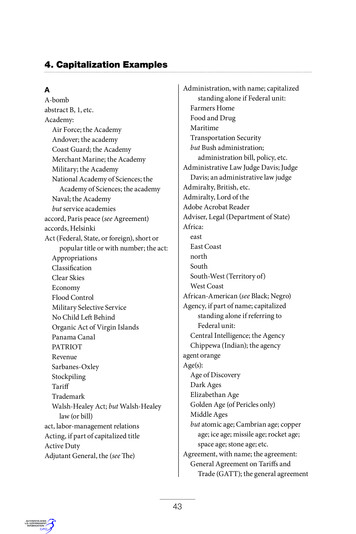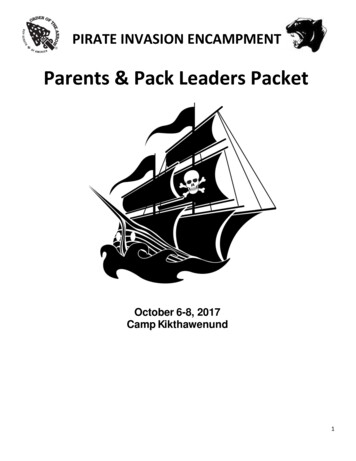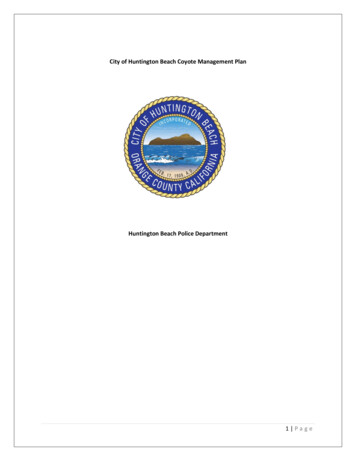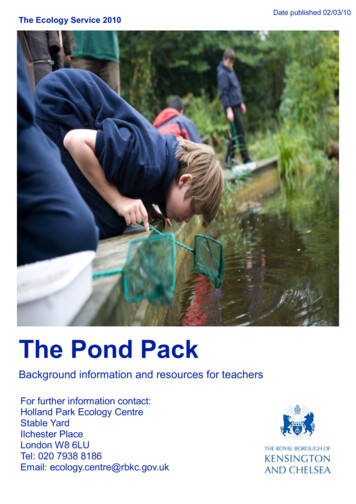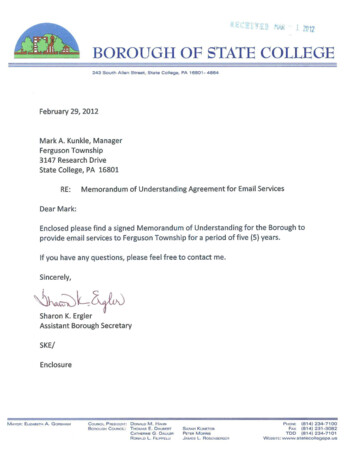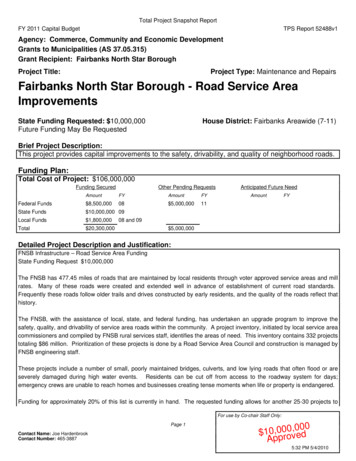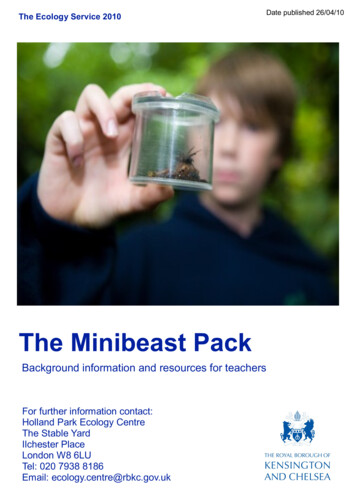
Transcription
The Ecology Service 2010Date published 26/04/10Title option here dependenton image 30 - 42ptSub-title, if required, goes here 18 - 26ptThe Minibeast PackBackground information and resources for teachersFor further information contact:Holland Park Ecology CentreThe Stable YardIlchester PlaceLondon W8 6LUTel: 020 7938 8186Email: ecology.centre@rbkc.gov.uk
ContentsPage TitlePage numberIntroduction and aims3Holland Park Ecology Centre andWildlife Area4How to conduct a minibeast hunt5Health and safety and risk assessment7Pre-visit ideas8Post visit ideas9Minibeast or invertebrate groups10Food chains and food webs12Invertebrate identification sheets andkey14Worksheets19Glossary29Letter to class about their forthcomingvisit30To book a self led session or one led by a member of the Ecology staff or for furtherinformation contact:Holland Park Ecology CentreStableyardIlchester PlaceLondon W8 6LUTel: 020 7938 8186Email: ecology.centre@rbkc.gov.ukWebsite: www.rbkc.gov.uk/ecology.2
IntroductionThis pack contains useful resources and ideas about minibeast hunting at HollandPark for KS1 and KS2 teachers. The content and activities can be adapted to suitthe different needs of classes and age groups. It aims to give teachers a betterunderstanding of invertebrates and habitats and provides suggestions for pre andpost visit activities.The pack contains photocopiable worksheets and identification sheets that may beused on the visit or could form the basis for follow up work.Key vocabulary is written in bold in the text and a short definition of each term canbe found in the glossary.What is a minibeast?The term minibeast is a more child friendly term for any small invertebrate. Aninvertebrate is an animal without a backbone and there are a vast range of differentspecies; insects, arachnids, worms, slugs and snails are all invertebrates. Furtherinformation on commonly found species can be found on page 9.Why hunt them?A minibeast hunt in the wildlife area is a simple and very enjoyable way for childrento discover more about the natural world. The science content can be tailored tomeet the needs of any age group.3
Holland Park Ecology Centre and Wildlife AreaThe Ecology Centre provides a base for studying the ecology and environment ofthe park. It has classroom and presentation facilities, curriculum-related displays,live and static animal specimens and a reference library. A range of scientificequipment is available for outdoor use. The centre can cater for groups of up tothirty children with accompanying adults.Holland Park Wildlife Area has a wildlife pond with dipping platform, woodland pathsextending round the enclosure, and three distinct habitats to study – pond,woodland and grassland.Sessions to the centre can be self led or led by a ecology education officer.4
How to conduct a minibeast huntMinibeast or invertebrates are found in a diverse range of terrestrial and aquatichabitats and there are many different ways of collecting them. Three methods givenare suitable for children to hunt for invertebrates in a woodland and grasslandhabitat.In all collecting children should be encouraged to use a plastic spoon to pick upcreatures as some minibeasts are very delicate.Woodland floor – log turningA great variety of invertebrates live in the leaf litter and under logs and stones.Organise your group into pairs and give each pair a magnifier pot and spoon.Ask the children to search under logs and stones for invertebrates. The creaturesfound can be scooped up with the spoons and placed in pots.Remind the children to put back the logs exactly as they found them and afterexamining the creatures the invertebrates should be place back under logs.A number of different creatures can go in one pot but large snails and slugs are bestin pots by themselves as they will produce a lot of sticky slime that can cover andharm the other creatures.H & S – The children should lift and replace logs carefully, watching out for fingersand toes. Larger logs should be lifted by adults only.5
Tree beatingThis method can be employed to seewhat creatures live in the canopy of thetrees.Equipment needed: a beating sheet,magnifier collection pots and spoonsTo do tree beating one child holds abeating sheet under a branch of a tree ora bush whilst another person shakesvigorously the branch. Any creatures onthe branch will fall on to the beatingsheet.The creatures disturbed tend to be fastmoving ones like spiders or flying oneslike lacewings.Sweep netsThis method is suitable for finding outwhat invertebrates live in long grass andstinging nettles.Equipment needed: a sweep net,magnifier collection pots and spoonsUsing a sweep net a child makes broadlong sweeps of the net through longgrass or nettles. After sweeping theinside of the net can be examined forcreatures.Points to note: check no one will be hitby the net when sweeping and try toavoid sweep near thorny plants as thesewill catch on the net. If sweepingthrough nettles be careful examining thecontents as there may be bits of nettlesinside the net.6
Health and Safety and Risk AssessmentMinibeast or invertebrate hunting is a very enjoyable activity but it does carry anumber of potential risks but these can be easily reduced by following theseguidelines1.Group ratio – Please ensure you have a ratio of at least 1 to 6 by the pond forKS2. I:2 for very young children.2.Behaviour in the woods – all children should be made aware of the parametersof the minibeast hunting area.3.To prevent infections children should be reminded not to put their fingers intheirs mouth, nose or eyes and should wash their hands afterwards.4.The hazards of touching plants like stinging nettles, holly and brambles shouldbe explained to all visiting groups. The eating of berries and fungi should bewarned against as some are very poisonous.5.The Wildlife Area is regularly checked however care should taken walkingaround for trip hazards and fallen branches. On rare occasions wasps nestunder logs; if you do discover a nest please vacate that area immediately andreport where the nest is to the Ecology Centre.6.Insects stings – please check with your class any children with allergies toinsect stings. If any member of your group is stung by a bee or wasp pleaseseek first aid and report the incident to the Ecology Centre.A full risk assessment for this activity is available on our website. Please contact theEcology centre for further enquiries. It is advisable to have the ecology centre andparks police numbers to hand when at the wildlife area in Holland Park.7
Pre-visit ideasBefore coming to the Ecology Centre with your class you may find the followingideas useful to set the scene and for further learning. A minibeast hunt is oftenconducted as part of a science unit about the living world but there is often scope tointroduce a cross curricular element as well.The term minibeast is often used but is interchangeable with invertebrate.Carry out a minibeast survey/hunt in your school grounds so to compare withthe Ecology area.Discuss the term minibeast and invertebrate – compare and contrast with otheranimals include themselves and other animals. Possible themes could beappearance, lifecycle, movement and how they breathe.Investigate the number of legs and body parts common invertebrates have.Ask them to research their favourite minibeast – internet or book basedDiscuss where we find minibeasts and what all animals need to survive.For younger children share story books like The Very Hungry Caterpillar byEric Carle. For longer reads books like Harry the Poisonous Centipede byLynne Reid Banks or Charlotte’s Web by E. B. White will spark interest.Explain what a habitat is and talk about different habitats they might find inaround the school and in Holland Park. For older children the term microhabitats could also be introduced.Read the letter to class (see appendix 1) as away of introducing the trip to yourgroup and prompting questions (letter is suitable for KS1 and lower KS2).Work on keys to identity creatures or objects.PSHE work on caring for the environment and how to care and respect livingthings.8
Post visit ideasA minibeast hunt can form part of a teaching unit in Science. It can also be the basisfor other cross curricular topics as well.Create mini beast clay monsters using clay and natural materials from thewildlife area.Create a giant land art mini beast using found materials gathered in the wildlifearea – research land art by artists such as Andy GoldsworthyDisplay work about minibeasts- children could draw or paint differentminibeasts this could help reinforce work on adaptation, camouflage etc.Literacy – children could write a story as a minibeast living in the wildlife area.Account of trip - non chronological report writing about the creatures found inthe woodland.Challenge the children to create a fantasy minibeast that is suited to living in aparticular habitat.Discuss the way different invertebrates use colour for warning others andcamouflage.Research project on a habitat or type of invertebrate.Follow up work on food chains and comparison work on the wildlife areahabitat to a more local area.Life cycle work.Use collected data to create graphs and charts on the number of differenttypes of invertebrates found in each habitat and the number of carnivores,herbivores and detritivores.Play woodland food chain or food web games to enable children to appreciatethe importance of mini beasts.Gardening ideas – create log piles and make ladybird hotels, plant flowers toattract bees and butterflies.9
Minibeast or Invertebrates groupsThis section provides some background information on commonly foundwoodland and grassland invertebrates.Insects (three body parts and six legs)All insects have three body parts – a head, thorax and abdomen and three pairsof legs as adults. They are the most common type of invertebrate with over22,450 species recorded in the UK. Their lifecycle is egg – larva – adult. Sometypes like butterflies and beetles undergo complete metamorphosis whilstothers like crickets and grasshoppers undergo incomplete metamorphosis.Social insectsBumblebee Bumble bees form small nests comprising of a queen and workerswhich are established yearly as only the queen bees hibernate. They are largerand furrier than honey bees and rarely sting.Wasp Common wasps live in colonies of up to 2000. They eat sweet things.Their nests are constructed from paper pulp created by the wasp chewing deadwood. The larvae eat dead insects and carrion and the adults feed on sugaryfoods and the liquid secreted by their larvae.A wasp sting’s “smell” causes nearby wasps to become more aggressive.Ant There are over 50 species in the UK. They live in large colonies run by aqueen. Ants can be herbivores, carnivores or omnivores depending on thespecies.BeetlesGround Beetle Ground beetles are fast nocturnal hunters. They havepowerful, sharp jaws for grabbing and crushing other insects and slugs. Duringthe day ground beetles hide under logs, stones and dead leaves.Ladybird Ladybirds are carnivores which mainly eat aphids. There are 46different types of ladybird in the UK, usually seen between March and October.The Harlequin is an aggressive alien species that is now the most commonspecies in the park.Other insectsEarwig Earwigs are long glossy brown insects with pincer like tails. Theyare nocturnal and eat both animal and plant matter. Female earwigs tendto their young until they reach adulthood.Devil’s Coach-horse This is a large predatory rove beetle that eatsinsects, worms and spiders. It has large pincers that it uses to crush itsprey. When threatened it puts its tail up like a scorpion and can emit afoul fluid. Can bite humans.10
Minibeast or Invertebrate groupsLacewings These are large green flies with long transparent wings. They arecarnivorous and eat aphids. Most only live for a summer although someoverwinter.Molluscs – gastropods (muscular foot)Glass snail This is a small snail with a thin translucent shell and blue body. Itfeeds on plants and algae.Garden snail This is the most common snail species. They arehermaphrodites and lay about 200 eggs. Snails eat mainly dead or dying plantmatter and hibernate during the winter. They are most active during moist warmweather. They feed using their toothed tongue known as a radula.Slugs Over 30 Slug species live in the UK. Common species to the park arethe great black slug (which can vary in colour from black to orange), theleopard slug (spotted) and the garden slug (black with an orange foot).Isopods (seven pairs of legs)Woodlice The most common of the 35 species native to the UK is the gardenwoodlouse. A woodlouse’s diet is rotting wood and a woodlouse can spend itswhole life on a single log. They give birth to over 150 babies which are carriedin a pouch by the females. Some species can roll into a ball when threatened.They have many common names like pillbugs, slaters, woodbugs, doodlebugsand sowbugs.Myriapods (numerous legs)Millipedes Millipedes means a thousand legs but most species only have afew hundred legs. All millipedes are detritivores and have two pairs of legs perbody segment.Centipedes A hundred legs is the literal meaning of the word centipede. Nospecies has exactly 100 legs. Centipedes are fast moving predators that killtheir prey by biting and injecting poison. Large centipedes can nip humans.Arachnids (four pairs of legs and two body parts)Harvestman These are close relatives of spiders but cannot spin webs and donot have fangs. They are long legged and have a round body. They catch theirprey by hooks on their legs.Spiders Spiders have eight legs, two body parts, fangs and can create silk.Most species catch their prey in webs whilst others hunt or make traps. Thereare no native deadly spider species although large species can bite.Annelids (segmented worm) Earthworm There are over 70 species in theUK. They eat dead organic matter in the soil and help fertilise the soil bybringing the nutrients to the surface. It is not true that cutting a worm in tworesults in two live worms, most often one or both parts die.11
Food chains and food websA food chain shows a simplified feeding relationship in a habitat. They are useful toshow how plants and animals are connected.Food webs show the different relationships more fully with many interconnectedfood chains.Green plants are termed producers as they convert energy from the sun into foodfor themselves by a process called photosynthesis.ConsumersConsumers are animals that get their energy directly or indirectly from plants.Primary consumers or herbivores eat plants as their source of energy. Examplesof herbivores in a woodland are grasshoppers and crickets.Animals that eat other animals are called carnivores. In a food chain, secondaryconsumers eat primary consumers to obtain their energy while a tertiary consumeris one that eats a secondary consumer or other animals.Omnivores eat both plant and animals.Detritivores eat dead organic matter (plants or animals) to survive. In a minibeasthunt on the woodland floor the majority of the animals collected are likely to bedetritivores as they are feeding on the dead leaves and wood.Examples of animals for each group are given overleaf. Please bear in mind thatthis is a simplified version as many animals can be in more than one category.12
Woodland Food ChainsAll animals and plants need food to grow and move.Animals that eat plants are called herbivores.Animals that eat other animals are called carnivores.Animals that eat both plants and animals are called omnivores.Animals that eat dead plants and animals are called detritivores.This is a simplified feeding or trophic level chart of the animals found in our pond.Invertebrate NameFeeding or Trophic vore/DetritivoreSlugHerbivore/DetritivoreGround BeetleCarnivoreMillipedeDetritivorePill ritivoreEarwigOmnivore/DetritivoreAntOmnivore - varies with ore13
Identification sheetsIdentification of common woodland invertebrates is very straightforward. Forchildren it can be made easier by focusing on features like size, number of legs andnumber of body parts. How the animal moves and behaves is also another good toolto identification.The following sheets and keys contain pictures of animals commonly found in ourwildlife area. It may be useful to also bring a field guide like the FSC guide to identifyother invertebrates as well.The colour of the animals on the sheets is generally accurate but many animals canbe differently coloured from what is showed depending on the time of year, stage intheir lifecycle and individual variation.Identification sheets 1 and 2 are suitable for foundation and key stage 1/2.Identification sheet 3 contains more detail about the animals and is suitable forupper key stage 2The key serves as a basic introduction to a branching database or a dichotomouskey for key stage 2.14
Identification Sheet 1Woodland MinibeastsEarthwormSlugSnailLadybirdGround beetleBeetle larvaSpringtailEarwigWaspBlowflyAntBumble beeDevil’s ede15Illustrations by Graham Giddens RBKC Ecology Service
Identification Sheet 2Meadow MinibeastsHolland ParkEcology CentreDragonflyPeacock butterflySpeckled wood adybirdWaspCraneflyShield lustrations by Graham Giddens RBKC Ecology Service
IdentificationSheet 3Woodland MinibeastsEarthwormSlughdLadybirdBeetle larvacSpringtailcEarwigWaspodBlowflycAntDevil’s arvestmancherbivoreo 17oBumble beeodCarnivorehGround beetleccSnailOmivoreddDetritivoreIllustrations by Graham Giddens RBKC Ecology Service
Woodland Minibeasts KeySTART HEREDoes it have legs?YESNODoes it have6 legs?YESIs the body in segments?NOYESDoes it have ahard case overits wings?Does it have 8legs?YESYESNOAre there more than15 segments ?NOYESNOInsect larvaeGroundBeetleSpiderDoes it have anarrow waist?YESNODoes it have along body?NONODoes it havea shell ?EarthwormYESYESNOSnailAntDoes it haveonly 2 wings ?Does it haveonly 4 legs on eachsegment ?YESWoodlouseNOSlugYESFlyMillipede 18CentipedeIllustrations by Graham Giddens RBKC Ecology Service
MinibeastHuntName:What creatures have you found? Where did youfind them? Try and find 8 different creatures.MinibeastWhere did youfind it?millipedeunder a log19Picture
InvertebrateHuntName:What creatures have you found? Where did youfind them? Try and find 8 different creatures.MinibeastWhere did youfind it?millipedeunder a logDescribe thehabitat conditionsdark and damp20Picture
21
Name:Date:All animals and plants need food to grow and move.Animals that eat plants are called herbivores.Animals that eat other animals are called carnivores.Animals that eat both plants and animals are called omnivoresWhen you have caught some minibeasts look at each animal closely. Fill in the table below.Name of SnailSlugGround BeetleMillipedePill tle LarvaWhich group of animals; herbivores, carnivores or detritivores are more abundant in thishabitat?Why?22
Because all animals and plants depend on each other for food these relationships arecalled Food Chains or Food Webs.2) Fill in the spaces in the Woodland Food Chain that is drawn below.Now draw a food chain using of one or more of the minibeasts that you have found.You can use other larger animals such as birds or mammals in your food chain ifyou need to but you must use at least one minibeast.23
Minibeast Investigations: IdentificationDraw and label your animal.Name youranimal.1.2.3.24What group of Name twoanimals does it characteristics ofbelong to?this type ofanimal.
Minibeast Investigations: Habitats and adaptationDraw and label your animal.Describe that habitat thatthis animal lives in1.2.3.25AdaptationHow does youranimal’s shape, sizeand colour suit thehabitat that it livesin?
Minibeast Investigations: ObservationDraw your animalWhat is thename of youranimal?Where did youfind youranimal?Choose 3 wordsfrom below thatdescribe youranimals habitat1.2.3.Habitat yUndergroundLeafy
Minibeast Investigations: MovementDraw your animalWhat habitatdoes youranimal livein?How does youranimal move?Which part of theanimal’s bodydoes it use tomove?1.2.3.Movement rsRippleSlimeJumpsSlowlyHops
Woodland MinibeastsName:Date:There are many types of minibeasts. Some have no legs, some have 6 legs and some have many legs. Thiscan be very helpful in identifying the animals that you find.1) When you have caught some animals look at each animal closely and try to identify them using the number oflegs to help you. Then fill in the table below.Name of creatureNo legsSix legsEarthwormSpiderSnailSlugGround BeetleMillipedePill tle Larva28More than sixlegsNumber ofeach creature found
GlossaryAbdomen The rear section of an insect’s body. It contains the heart, the stomachand the reproductive organs.Adaptation A characteristic that makes a plant or animal particularly suited to ahabitatAntennae An insect’s two feelers, used mainly for smelling and touching. They areattached to the insect’s head.Carnivore An animal that eats meat.Consumer An animal that derives its food from another organism – plant or animal.Ecology The study of the relationships plants and animals have with one anotherand the environment.Exoskeleton An external hard body covering, providing protection and support.Many invertebrates have exoskeletons.Food chain A linear representation of the order that organisms are eaten by eachother. Shows the flow of nutrients and energy. Most food chains start with a greenplant.Food web Similar to a food chain, but the feeding relationships between all of themembers of an ecosystem.Habitat The place where a organism lives and finds food, water and shelterHerbivore An animal that eats plants.Incomplete metamorphosis As some insects grow and develop, their bodieschange gradually during several moulting sessions until the fully formedadult emerges.Invertebrate An animal with no backbone.Metamorphosis As some insects grow and develop, their bodies change shapedramatically. These changes are the insect’s metamorphosis.Omnivore An animal which eats both plants and other animals.Proboscis A hollow feeding tube which some insects use to suck up liquid foods.Producer Plants that make their own food by photosynthesis.Pupa A central stage in the metamorphosis of an insect. The pupa looks like asmall sack, and the adult insect develops inside it. The pupa is sometimes referredto as a chrysalis.Radula A rasping mouth organ used by molluscs such as snails.Social insects Insects such as wasps, bees and ants that live together in colonies.They share jobs such as rearing the young and obtaining food.Species A particular type of living thing. Over one million species of insect havebeen recorded by entomologists.Thorax The middle section of an insect’s body. The insect’s legs and wings arejoined to the thorax.Tracheae Air tubes allowing air to pass to and from an insect’s body.Vertebrate An animal with a backbone.29
Letter to read to classSuitable for key stage 1 and lower key stage 2Dear Class,We are happy to hear that you are coming to Holland Park Ecology Centre tostudy habitats. The two we have in our wildlife area are a woodland and a pond.Can you think of some features each of these habitats?At the pond, you will have the chance to do pond dipping. Can you think ofinstructions we will need to follow to keep everyone safe and happy by the pond?What creatures might live in our pond? If you are coming in spring you shouldcatch some tadpoles and maybe newts. Do you know what type of animal theseare and what the different stages of their lifecycle? Many other creatures only livepart of their lives in the pond – have you ever heard of nymphs and larvae?In the woodlands you will be hunting for invertebrates or minibeasts. Can youthink why we will use spoons to pick them up? All sorts of invertebrates areadapted to live in different parts of the woodland. Some are herbivores or primaryconsumers; some are predators or carnivores whilst others eat dead plants andwood and are called detritivores. Can you think of examples of each?Invertebrates come in all shapes and sizes and can be classified into groups byfeatures like their number of legs and size. Do you know any creatures that haveno legs, six legs or many legs? We will use identification sheets and keys to workout what they are.After looking at our finds we will let them go and head back to the centre to washour hands (why?). Hopefully by the end of the session you find lots of creaturesand learn about all the things they need to thrive in their habitat. Maybe you willhave gained some ideas on how to improve your school grounds for wildlife.We look forward to seeing you all.Best wishes from the Holland Park Ecology Team30
The Minibeast Pack Background information and resources for teachers Date published 26/04/10 Title option here dependent on image 30 - 42pt . Insects (three body parts and six legs) All insects have three body parts - a head, thorax and abdomen and three pairs of legs as adults. They are the most common type of invertebrate with over



